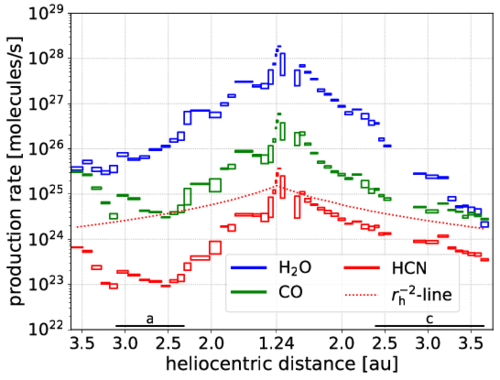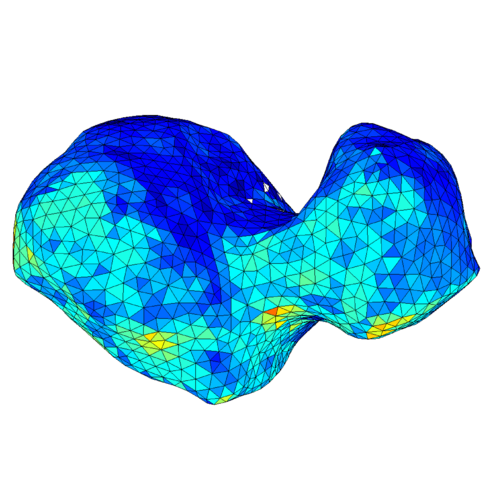Gas production for 14 species on comet 67P/Churyumov-Gerasimenko from 2014-2016
- 1Zuse Institute Berlin, Berlin, Germany (laeuter@zib.de)
- 2Department of Physics, Harvard University, USA
- 3University of Bern, Physikalisches Institut, Switzerland
Abstract
During a two year period between 2014 and 2016 the coma of comet 67P/Churyumov-Gerasimenko (67P/C-G) has been probed by the Rosetta spacecraft. Density data for 14 gas species was recorded with the COmet Pressure Sensor (COPS) and the Double Focusing Mass Spectrometer (DFMS) being two sensors of the ROSINA instrument. The combination with an inverse gas model yields emission rates on each of 3996 surface elements of a surface shape for the cometary nucleus.
The temporal evolution of gas production, of relative abundances, and peak productions weeks after perihelion are investigated. Solar irradiation and gas production are in a complex relation revealing features differing for gas species, for mission time, and for the hemispheres of the comet. This characterization of gas composition allows one to correlate 67P/C-G to other solar and interstellar comets, their formation conditions and nucleus properties, see [3].
Gas production
We analyze in-situ density data of the two sensors COPS and DFMS (see [1]) for the 14 major and minor gas species H2O, CO2, CO, H2S, O2, C2H6, CH3OH, H2CO, CH4, NH3, HCN, C2H5OH, OCS, and CS2 between August 1st 2014 and September 5th 2016 and heliocentric distances rh between 3.5 au and 1.24 au. Based on the inverse gas model (section below) the temporal evolution of the cometary gas production is evaluated for all 14 gas species, see [5] and [6].

Figure 1: Temporal evolution of the production rates for comet 67P/C-G during the apparition in 2015. The boxes indicate the systematic uncertainties with respect to the limited surface coverage only. The rh-2-line specifies a radiation model assuming linear relation between solar irradiation and gas production. The horizontal bars indicate two time intervals Ia and Ic before and after perihelion.
Fig. 1 shows the production rates for the three species H2O, CO, and HCN complemented by the line for an idealized production assuming a gas production ∼rh−2. The H2O fraction is more than 80 % of the cometary production at peak gas activity during the interval 17 d to 27 d after perihelion. During the time interval Ic from 190 d to 380 d after perihelion, the productions for H2O, O2, CH3OH, H2CO, and NH3 follow power laws rhα with α ≤ −4.5. A linear relation between solar irradiation and gas production at that time can be excluded for these gases. The group of gases containing CO2, CO, H2S, CH4, HCN, C2H5OH, OCS, and CS2 holds higher exponents −3 ≤ α (see CO and HCN in Fig. 1) in interval Ic. Restricted to the southern hemisphere, the exponents α further approach −2 such that a linear relation between solar irradiation and gas production can be assumed.
As shown in Fig. 1 during the time interval Ia from -290 d to -180 d before perihelion the gases CO and HCN show a significant production decrease although solar irradiation increases at the same time. CO2, H2S, O2, and C2H6 remain nearly constant during Ia. [2] report production decrease for CO and stagnation for HCN on comet C/1995 O1 Hale-Bopp which might be explained by interacting sublimations of two different gas species.

Figure 2: Nucleus of comet 67P/C-G approximated with 3996 triangular elements. Colors indicate source strength of H2O two weeks after perihelion August 2015.
Model and data analysis
Gas density data of the sensors COPS and DFMS are applied to a simplified inverse gas model for collisionless gas expansion around the nucleus of 67P/C-G, see [4]. Each triangular surface element of a shape model with 3996 elements (see Fig. 2) holds a single gas source described by [7]. Within each of 50 time intervals lasting 9 d to 29 d, each source holds a constant emission rate. Numerical efficiency allows to fit all emission rates on the elements, in all intervals, and for all gases on the HLRN-IV supercomputer.
Summary
The temporal evolution of the gas production of comet 67P/C-G for 14 gas species for a two year period during the apparition 2015 is evaluated. Solar irradiation and production are in a complex relation and show different phenomena. For a number of gases, including CO2, production is close to a rh-2 law, during parts of the outbound mission. For other gases, including H2O, steeper gradients hold. Inbound CO and HCN hold decreasing production with increasing irradiation at the same time.
Acknowledgements
The work was supported by the North-German Supercomputing Alliance (HLRN). Rosetta is an European Space Agency (ESA) mission with contributions from its member states and NASA. We acknowledge herewith the work of the whole ESA Rosetta team. Work on ROSINA at the University of Bern was funded by the State of Bern and the Swiss National Science Foundation.
References
[1] Balsiger H., et al., 2007, Space Science Reviews, 128, 745
[2] Biver N., et al., 2002, Earth, Moon, and Planets, 90, 5
[3] Bodewits D., et al., 2020, Nature Astronomy
[4] Kramer T., Läuter M., Rubin M., Altwegg K., 2017, MNRAS, 469, S20
[5] Läuter M., Kramer T., Rubin M., Altwegg K., 2019, MNRAS, 483, 852
[6] Läuter M., Kramer T., Rubin M., Altwegg K., 2020, MNRAS, submitted
[7] Narasimha R., 1962, J. Fluid Mech., 12, 294
How to cite: Läuter, M., Kramer, T., Rubin, M., and Altwegg, K.: Gas production for 14 species on comet 67P/Churyumov-Gerasimenko from 2014-2016, Europlanet Science Congress 2020, online, 21 September–9 Oct 2020, EPSC2020-319, https://doi.org/10.5194/epsc2020-319, 2020

